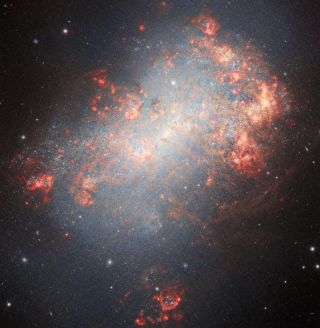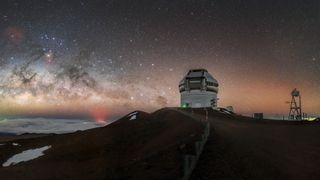A starburst galaxy, ablaze with stars in the process of forming, is devouring surrounding dwarf galaxies in a stunning new image from the Gemini North twin telescopes.
Bright red and pink strands of gas and dust as well as bright white and blue stars seen in the image compose the galaxy NCG 4449, also known as Caldwell 21, which is located around 13 million light-years from Earth in the constellation Canes Venatici. NCG 4449 is classified as an irregular Magellanic-type galaxy, reflecting its loose spiral structure and close resemblance to the satellite dwarf galaxy of the Milky Way, the Large Magellanic Cloud (LMC).
The image of NCG 4449 was released to celebrate 25 years of Gemini North, which consists of an 8.1-meter diameter optical and infrared telescope located on the dormant volcano Maunakea in Hawaii. The volcano rises about 13,825 feet (4,214 meters) into the dry and stable air of the Pacific, giving Gemini North a view of the cosmos that is mostly unhindered by Earth’s atmosphere.
Related: James Webb Space Telescope gets to the heart of a smoking starburst galaxy (images)
Though stars have been forming in NGC 4449 for billions of years, the galaxy is currently in the midst of a bout of extreme star birth, which astronomers call a “starburst.”
NGC 4449 stands out even for a starburst galaxy. Its star formation is widely distributed throughout its body rather than concentrated in a central region, as seen in most starburst galaxies. This widespread, or “global,” star birth in NGC 4449 is evidenced by the presence of the galaxy’s youngest stars both in its heart and in streams of gas and dust threaded throughout the galaxy.

The bright starburst galaxy NGC 4449 as seen by the Gemini North telescope (Image credit: International Gemini Observatory/NOIRLab/NSF/AURA Image Processing: J. Miller (International Gemini Observatory/NSF NOIRLab), M. Rodriguez (International Gemini Observatory/NSF NOIRLab), T.A. Rector (University of Alaska Anchorage/NSF NOIRLab), M. Zamani (NSF NOIRLab))
The global star formation of NGC 4449 means this galaxy resembles some of the earliest galaxies in the cosmos, which grew by cannibalizing smaller star systems and taking their contents for themselves.
Breaking space news, the latest updates on rocket launches, skywatching events and more!
Like these earliest galaxies, it’s likely NGC 4449’s widespread star formation is the result of it devouring smaller dwarf galaxies that surround it. This is possible because NGC 4449 is part of the M94 group of galaxies, which lie in close proximity to a few surrounding dwarf galaxies, two of which this starburst galaxy is currently interacting with.
One of these dwarf galaxies is extremely dim and is currently being absorbed by NGC 4449. This “stealth merger” is evidenced by a diffuse stream of stars on one side of NGC 4449, but is almost undetectable in visible light due to the diffuse nature and low stellar mass of the galaxy being cannibalized.
Astronomers can infer the merger thanks to the presence of a massive globular cluster, an ancient tightly bound conglomeration of stars embedded within the outer halo of NGC 4449. Astronomers think this globular cluster is what remains of a gas-rich satellite galaxy that is now almost fully devoured by NGC 4449.

The Gemini North telescope which recently celebrated its 25th anniversary. (Image credit: International Gemini Observatory/NOIRLab/NSF/AURA/P. Horálek (Institute of Physics in Opava))
As NGC 4449 absorbs smaller dwarf galaxy companions, tidal interactions send shockwaves through the galaxies’ gas and compress it. This is seen as glowing red patches in the NGC 4449 image, which indicate the presence of hot ionized hydrogen, a telltale sign of active star birth.
A plethora of hot, young blue star clusters can be seen scattered through the galaxy as they grow using gas and dust supplied by dark filaments threaded throughout NGC 4449. This supply of raw materials for star formation won’t last forever. At the current rate, NGC 4449 is birthing stars, the gas supply feeding this starburst period will run out in around a billion years.
June 25, 2024 marked exactly 25 years since a dedication ceremony was held on Maunakea, Hawaii, to unveil Gemini North, a new world-class 8.1-meter telescope at the time. This is when it revealed its first-light images. In the two decades since that day, Gemini North has made a massive contribution to our understanding of the universe.
Gemini North’s partner, Gemini South, is located on a mountain in the Chilean Andes called Cerro Pachón in northern Chile. Gemini South also consists of an 8.1-meter diameter optical and infrared telescope but is three years younger than Gemini North, first opening its eye to the cosmos in January of 2002.
Join our Space Forums to keep talking space on the latest missions, night sky and more! And if you have a news tip, correction or comment, let us know at: [email protected].
Robert Lea is a science journalist in the U.K. whose articles have been published in Physics World, New Scientist, Astronomy Magazine, All About Space, Newsweek and ZME Science. He also writes about science communication for Elsevier and the European Journal of Physics. Rob holds a bachelor of science degree in physics and astronomy from the U.K.’s Open University. Follow him on Twitter @sciencef1rst.
>>> Read full article>>>
Copyright for syndicated content belongs to the linked Source : Space.com – https://www.space.com/starburst-galaxy-dwarf-galaxy-star-birth-video































